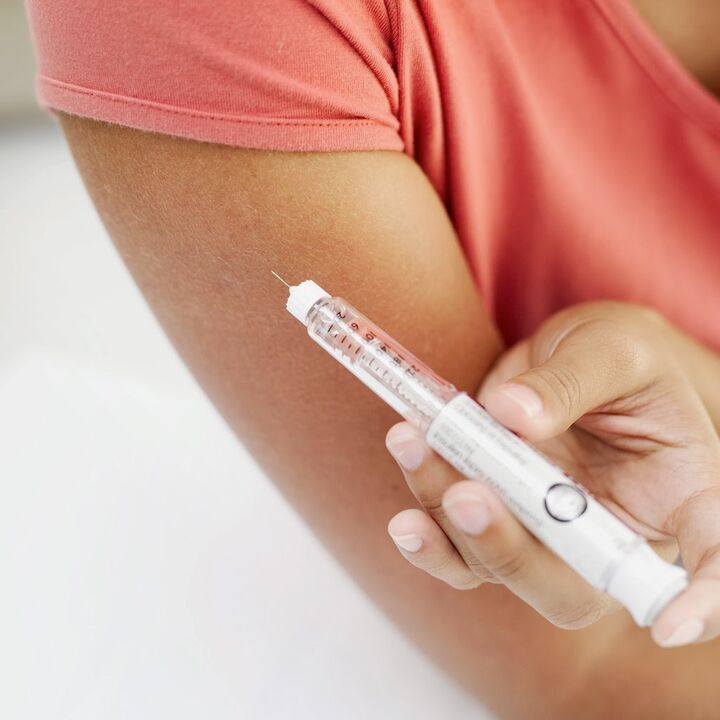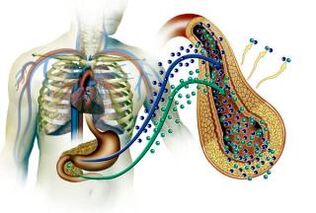Diabetes Mellitus is a serious disease, characterized by lack of insulin in one or second degree. As a result of pathology, hyperglycemia may occur, ie blood sugar increases, which will lead to different metabolic disorders and complications.
Diabetes is in third place in overcoming after cancer and cardiovascular diseases. Through the world, more than one hundred million people with this disease are currently known. Every 15 years, the number of cases doubles.
Drugs that can completely eliminate the manifestations of diabetes do not exist. If the disease is not treated for a long time, then irreversible disorders appear in varieties of different organs.
Notices in the symptoms of pathology on time, you should know which types of diabetes exist.
Types of diabetes

In medicine, several types of diabetes are released. The term itself reveals the entire list of diseases with common features. The characteristics of diabetes and their species are in the pathological level of blood sugar.
There are a lot of reasons why insulin cannot cause glucose cell cells. Still, the result is always the same: with strong saturating blood with sugar, cells cannot eat normally.
When the sugar does not fall into the cells, it pulls the water over yourself. The liquid of filling the bloodstream passes through the kidneys, and dehydration occurs. Despite what diabetes exist, there are such symptoms:
- Dry mouth.
- Thirst.
- Frequent and abundant urination.
Each type of illness is characterized by one's own characteristic effect on the human body. Diabetes, of which species have their differences, perhaps:
- Neharna and sugar.
- Latent.
- Potential, expressed in the predisposition of the disease.
- Insulin-looking and insulin-planning.
- Laby.
- Renal.
- Postoperative, appears after the surgery on the pancreas.
- Pankreatic, expressed in lazy pancreas.
- Nepanocrete, is not connected to the lighter impairment.
First Type of Melitus Diabetes

Insulin-helmed diabetes is called autoimmune or viral impairment of pancreas, an organ that produces insulin. People with type 1 type, insulin or no or in general or is in very small amounts.
Statistics suggest that the type 1 disease appears at a young age. It is determined by such symptoms as a common serious thirst, quick urination, rapid weight loss, a strong feeling of hunger and the appearance of acetone in urine.
The treatment of this variety of diseases is the introduction of the desired dose of the hormone from outside. Other therapeutic actions are completely inefficient. The first type of diabetes usually occurs due to genetic predisposition. Such a disease may cause one or more negative factors, initiating pathological changes in the immune system.
As a result, the cells of pancreatics are deformed, producing insulin. Lack of hormone leads to the fact that carbohydrates cannot take full care in the body, and the lack of energy is trying to make up for processing fat.
Toxic substances begin to enter the brain. Therefore, it is extremely important to constantly control the current state of the body and the contents of glucose in the blood.
The disease may occur because of:
- Infections.
- Stress.
- Sedentary lifestyle.
- Autoimmune diseases.
- Heredity.
- Inal meals.
Such diabetes is up to 15% of the total number of patients. Children and adolescents are most often disgust. Ailment appears due to passive lifestyle and permanent use of carbohydrates. Obesity and diabetes can appear when taking:
- Soda drinks.
- Smoked meat.
- Preserved products.
- Fast food.
Sometimes diabetes, and then obesity appears. Type 1 The disease has such symptoms:
- Weakness.
- Irritability.
- A feeling of fatigue.
- Nausea.
- Reinforced thirst.
- Calls for urination.
Often patients lose weight of body weight quickly or vice versa. Diabetes can be:
- Basic: Genetic, essential.
- Secondary: Thyroid, pituitary, steroids.
The disease can be mild, medium or serious. The nature of the exchange rate is divided into insulin-divided and insulin-planing type. Due to the high blood sugar content, buds and blood vessels are deformed.
Therefore, people suffering from type 1 diseases, in many cases loses vision, becoming almost blind. There are also two main manifestations: first kidney violation, then - the failure of this organ. Often patients record the pain and stiffness of the limbs. This is due to violation of blood circulation and nerve damage.
In the event of blood flow violation in their feet, there is a great risk of leg amputation. With the disease type 1 there is a large amount of cholesterol in the blood, therefore, in the diabetics, cases of stroke or myocardial are not unusual.
In men with diabetes, impotence is often developed, because nerve and blood vessels cease to exist in healthy mode. Due to pathology appear:
- Obesity.
- Pancreatitis.
- Dermatopathy.
- Nephropathy.
- Encephalopathy.
One of the pathologies that represent a great danger is a hypoglycemic coma. This condition often leads to death.
Diabetes patients should determine blood sugar level each day using special devices created for home conditions. If necessary, urine is prescribed for sugar content.
If the glucose level increases, then insulin injections are needed to treat type 1 type. This hormone is involved in metabolism, allowing the body to process carbohydrates.
If there is no adequate treatment of type 1 diabetes, serious complications appear. In some cases, death is possible. Sometimes a person needs hospitalization to establish a complexity of the situation.
In stationary conditions, the patient has taught new sugar management skills.
Another type of Melitus Diabetes

This type of disease occurs with insufficient insulin products from pancreas. The situation is also worsened by reducing the mobile activities of this organ. Normally, pathology is formed due to hereditary non-hydrogen tissue in hormone.
Fabrics that are subjected to insulin have insulin receptors. Due to the occurrence of the pathology of these receptors, the immunity of tissue to insulin is developed. Hormone excretion does not reduce, form a relative lack of insulin.
In patients with obesity, above all, there is a reduction in the function of the insulin receptor. The dressing leads to excess blood glucose generation, until-the-controversion tissues do not allow glucose to get in cells.
Since the required amount of insulin is required to get sugar in cells, its overspread products begin, which is wrapped in the exhaustion of beta cells.
2 types of diabetes in medicine are not considered hereditary pathology, but a disease of the wrong way of life. Even with existing difficult heirs, such a violation will not form if:
- The use of sweet products and other "fast" carbohydrates is limited.
- No overeating.
- There is constant control over the calf mass.
- Physical exercises are constantly performed.
Type 2 diabetes symptoms are not specific. The person does not notice their events, in most cases, because there is no significant deterioration in well-being. But knowing the symptoms, you can't miss the moment of their appearance and turn to the doctor in time, determining blood glucose concentration. Therefore, a successful diabetes fee will be created, the risk of complications will be significantly reduced.
The main manifestations of this pathology:
- Dry mouth.
- Increasing the volume of urine, which is why a person constantly wakes up at night.
- Strong thirst.
- Itching of mucosa.
- Powerful appetite associated with the failure of leptin synthesis.
The presence of diabetes can also discuss:
- Slowed wound renewal.
- Furunculosis.
- Impotence.
- Fungal infections.
Ailment can be found the first time he enters the hospital for stroke or heart attack. Such diseases indicate that diabetes are in a serious phase.
Common symptoms are manifested only with increasing sugar levels above the kidney threshold - 10 mmol / l. In addition to this increase in glucose, it appears in the urine. If the value does not reach 10 mmmol / l of blood, then a person does not feel changes in the body.
It can be noted that random installation of type 2 diabetes is a very common phenomenon.
2 types are used for diabetes therapy: the following funds are used:
- Biguanidi.
- Thiosoliddo.
- Cost sulfanillarochevin.
- Glina.
Gestational diabetes
The gestational form of illness can occur in pregnant women. Pathology is formed due to insufficient insulin production, which is needed to regulate blood sugar.
During pregnancy, the female body is forced to produce a large amount of insulin, which provides fetal needs. This procedure is particularly relevant in the second half of the childhood childhood.
If there is a lack of insulin, the blood glucose level is constantly increasing, providing the opportunity to form a gestational type of diabetes. This disease usually takes place on its own, immediately after childbirth.
This is a characteristic characteristic that distinguishes it from other types of diabetes that are chronic.
Latent diabetes

A large number of vague moments is associated with diabetes. The most common types of diseases of the first and other species are. It is worth noting that there is an intermediate type of this dangerous disease called Lada Diabetes.
Such a disease occurs in adulthood. This variety of diseases is dangerous in this, can be disguised in type 2. diabetes. The latent form of the disease is very difficult.
Lada is a serious autoimmune disease. The immune system begins to attack their own organism, constantly destroying beta cells produced by insulin in pancreas. But such patients can be long without injection insulin, unlike those who are more than 1 diabetes.
With latent form of diabetes, the immune processes act quite slowly. Work beta cells are preserved on the pancreas. Patients show medicinal treatment that are intended for diabetics with 2. Type of diabetes. Over time, antibodies destroy more and more beta cells, leading to a serious reduction in the amount of insulin and the inevitable use of insulin therapy.
Hidden diabetes
Hidden diabetes Mellitus has another name: Latent or sleep. This pathology is diabetes at an early stage.
With the preliminary phase of diabetes, sugar and his blood indicators never cross the norm. In the initial phase of the disease, a violation of glucose tolerance is recorded. Furthermore, after sugar load, a person was observed in the blood, a very slow, but a decrease in glucose concentration.
Such people have a rather high probability of diabetes in 10-15 years. This tractor does not require specific complex therapy, but it is important to constantly medical observation. The latent type of diabetes meliteness can occur over the years.
Develop her, sometimes it is enough to survive a serious nerve disorder or get a viral infection.
Non-adalar diabetes
Nemanal diabetes is a pathology, which is caused by the absolute or relative lack of vasopres, hormones, which has antidiate effect. People suffer from sudden urination and thirst. Sleep is significantly broken, and a person cannot normally return strength.
About 6-15 liters of loose, light urine are released daily. There is also a lack of appetite and weight loss. The person is constantly tired and irritated, dry skin and lack of sweating are observed.
Sub-compensated diabetes
Diabetes Mellitus is a disease consisting of damaged carbohydrate metabolism. All medical measures are focused on normalization. It is quite difficult to achieve a permanent effect. Due to long-term therapy, the level of metabolism of carbohydrates can fluctuate and have different values.
There are several forms that allow you to compensate for this dangerous disease. We are talking about:
- Decompensated.
- Sub-compensated.
- Compensated form.
The decopension form is characterized by the fact that there is almost no improvement of carbohydrate metabolism. There is a large blood glucose concentration, acetone and sugar are in the urine.
The subcompension diabetes is a pathology in which blood sugar is different from the norm, there is no acetone in the urine. With the compensation form of the disease, the person has glucose to normal, while there is no sugar in the urine.
Laby Diabetes
The disease may differ in the nature of the exchange rate on Labil and stable. Labil type of illness is characterized by significant blood glucose fluctuation per day.
In such people, hypoglycemia appears, most often evening. Late in the night and early in the morning there is a strong thirst and hyperglimp. The hidden course of the disease is often accompanied by the formation of ketoacidosis, which often leads to a diabetic coma.
Fast replacement of hypoglycemia hyperglycemia is characteristic of young and childish diabetes. The stability of the disease exchange rate is characteristic of its average phase. The disease continues to be labeled when it is difficult.























